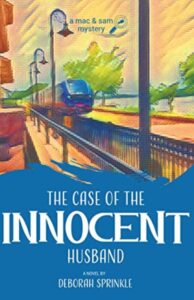© 2023 Deborah Sprinkle 
Suspense makes a story worth our time. Think about it. What keeps you glued to the movie screen or turning the pages?
Two of the elements for creating suspense are a strong hook and creating characters (especially a protagonist) the reader cares about.
The Hook
As authors, we’re taught to start with suspense. Like a fisherman, we bait our hook with suspense and reel in our readers. Let’s look at a couple of first sentences.
“The pain compelled her—
No . . . propelled her.” (Acceptable Risk by Lynette Eason)
Are you hooked? I am, and I’ve read the book! Here’s another one.
“In the cold, nearly colorless light of a New England winter, two men on horseback traveled the coast road below Boston, heading north.”
What’s so urgent about getting to Boston that they would leave their cozy fires on this miserable day? This is the first line in David McCullough’s book, John Adams, which shows that even nonfiction writers benefit from using suspense in their writing.
In fiction, the basics for building suspense are the same no matter the genre. We instill anticipation, from romance—where we follow lovers through a sequence of overcoming setbacks—to science fiction—where the characters encounter the same basic problems but in different worlds.
Characters Readers Care About
After the hook, suspense depends on our readers’ caring about our characters. Again, we do this in the beginning. Here’s what Lynette Eason writes about her protagonist on page one.
“When was the last time she’d cried? The day her father died? No, it was the day the Taliban had driven the van loaded with explosives into the playground at the orphanage.”
Our hearts ache for this woman who is experiencing so much pain. We turn the page praying she’ll find relief.
But what about our nonfiction writer? At the bottom of paragraph three, David McCullough gives this description of John Adams.
There were some, even among his admirers, who wished he talked less. He himself wished he talked less, and he had a particular regard for those, like General Washington, who somehow managed great reserve under almost any circumstance.
I can totally relate to Mr. Adams!
Once we care about the characters, it’s easier to build suspense because the things that happen to them mean something to us, the readers.
These are just a couple of elements that help build suspense in our stories.
What are some of the other components you use to build suspense in your writing?
_________________________
Deborah Sprinkle has written a series of three romantic suspense novels, Trouble in Pleasant Valley. She’s won many awards, including one for a short story that inspired her new mystery series set in Washington, Missouri.  The Case of the Innocent Husband is available on Amazon, and the second book, The Case of Mistaken Identity, will publish in August, 2023. She is hard at work on the third book. Connect with Deborah on her website or facebook.
The Case of the Innocent Husband is available on Amazon, and the second book, The Case of Mistaken Identity, will publish in August, 2023. She is hard at work on the third book. Connect with Deborah on her website or facebook.

